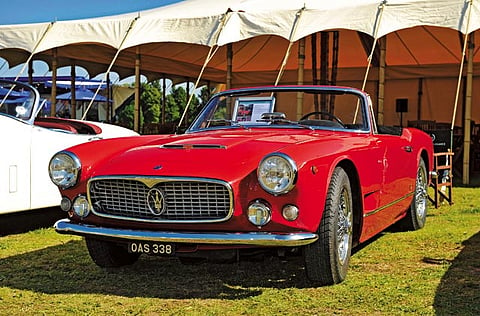Maserati 3500
It was the first gran turismo built by the Trident in significant numbers

The Maserati brothers were very much involved in racing since the Twenties, and the cars they built were collecting accolades from races across the globe for nearly four decades, including the great Juan Manuel Fangio’s Formula 1 championship win in 1957. But the Trident could not replicate this success with its road-going sportscars, which were dominated by local rival Ferrari.
Although they already had the A6 and the A6G in the late Forties and the early Fifties, none of these could match Ferrari in performance or prestige.
Realising the urgent need for a stylish, sophisticated yet sporty car, Maserati commissioned a new model, and on March 20, 1957, two prototypes were presented at the Geneva show — one penned by Allemano and the other by Carrozzeria Touring. The latter was green-lighted for production as the Maserati 3500 GT.
Although the 3500 GT was a successor to the A6G, much of the car was completely new. The brand-new, straight-six with twin camshafts and twin-plug ignition was the first Maserati engine designed solely for production vehicles, although it took inspiration from the one that powered the 250F grand prix cars and the 300S and 350S sportscars. With three twin-choke Weber carburettors, it developed 230bhp and, mated to a ZF four-speed gearbox, reached a top speed of 210kph.
The attractive and elegant four-seater body was built in Milan from aluminium panels produced by Touring using its lightweight Superleggera production principles.
The 3500 GT was continuously developed and updated during its lifetime, with front-disc brakes being available as an option in 1959, the same year the convertible 3500 GT Spider was launched. Penned by Giovanni Michelotti, who worked for Vignale of Turin, the Spider’s design was more muscular and the body was built from steel.
With the Jaguar E-Type sending shivers down their spines, almost every Italian carmaker scrambled to come up with a response.
In 1961 Maserati fitted a Lucas fuel-injection to the 3500, calling it the 3500 GTI, making it the first Italian production car to feature an injection system. However, persistent problems forced many owners to subsequently get their fuel-injection replaced with Webers.
There were a host of other changes around this time, including a new five-speed manual transmission, disc brakes on all four corners and a few cosmetic updates like deletion of front fog lights and revised taillights.
Altogether a little more than 2,200 GT coupés and convertibles were built between 1957 and 1964, which is not that many.
But the 3500 GT is significant because it enhanced Maserati’s reputation as a sportscar maker worthy of rivalling Ferrari and brought about the marque’s transition from a manufacturer of racecars, to road cars and then to supercars. And its sales success brought in some much-needed cash to stabilise the company financially.
So if you come across one for a reasonable price — which should be in the range of Dh275,000 to Dh300,000 — snap it up, as you’re buying an important piece of Maserati history and an entry pass to any classic motor show in the world.
Sign up for the Daily Briefing
Get the latest news and updates straight to your inbox

